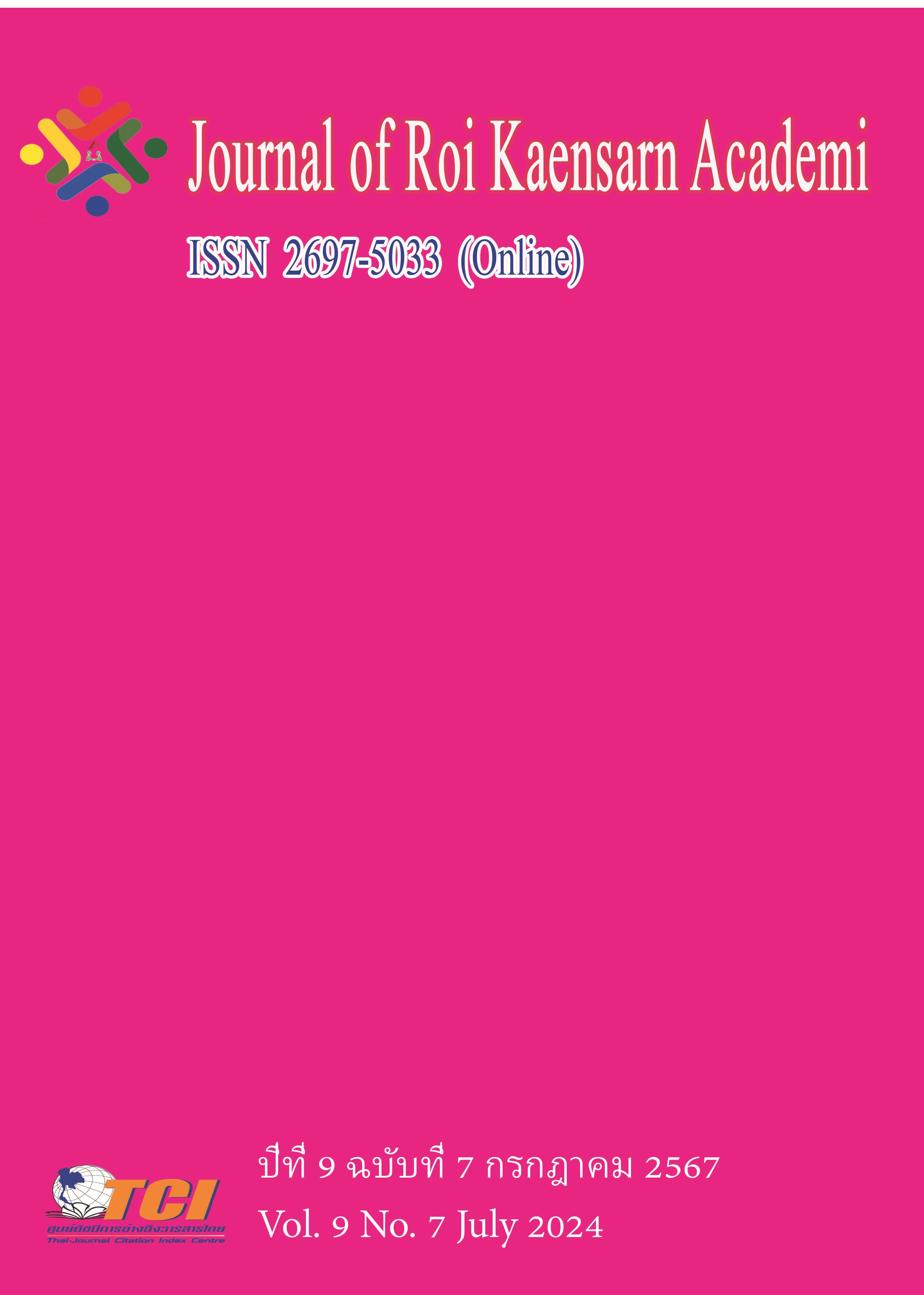ความได้เปรียบทางการแข่งขันเป็นตัวแปรถ่ายทอดแนวปฏิบัติการจัดการคุณภาพเชิงพฤติกรรมสู่ผลการดำเนินงานของธุรกิจโรงแรม
Main Article Content
บทคัดย่อ
งานวิจัยนี้มีวัตถุประสงค์เพื่อศึกษา 1) แนวปฏิบัติการจัดการคุณภาพเชิงพฤติกรรม ความได้เปรียบทางการแข่งขัน ผลการดำเนินงานของธุรกิจโรงแรม และ2) ความได้เปรียบทางการแข่งขันในฐานะตัวแปรคั่นกลางเชื่อมแนวปฏิบัติการจัดการคุณภาพเชิงพฤติกรรมสู่ผลการดำเนินงานธุรกิจโรงแรม กลุ่มตัวอย่างคือ ผู้บริหารของโรงแรมภาคเหนือตอนล่างจำนวน 288 คน โดยใช้เครื่องมือแบบสอบถาม การวิเคราะห์ข้อมูลใช้สถิติพรรณนาหา ค่าความถี่ ค่าร้อยละ ค่าเฉลี่ย ค่าส่วนเบี่ยงเบนมาตรฐาน และวิเคราะห์ข้อมูลด้วยโมเดลสมการโครงสร้างด้วยโปรแกรม AMOS และ PROCESS
ผลการวิจัยพบว่าผู้ตอบแบบสอบถามให้ความสำคัญแนวปฏิบัติการจัดการคุณภาพเชิงพฤติกรรมคือการมุ่งเน้นลูกค้า การมุ่งเน้นพนักงาน ความเป็นผู้นำ ที่มีค่าเฉลี่ยสูงที่สุด รองลงมาคือความได้เปรียบทางการแข่งขัน และผลการดำเนินงานตามลำดับ โมเดลเชิงทฤษฎีผลการดำเนินงานองค์กรมีความสอดคล้องกลมกลืนกับโมเดลจากข้อมูลเชิงประจักษ์ในระดับอยู่ในเกณฑ์ดี (c2 = 16.907, df = 12, p-value = 0.153, c2/df = 1.409, GFI = 0.985, IFI = 0.977, CFI = 0.975, RMSEA = 0.038) และความได้เปรียบทางการแข่งขันเป็นตัวแปรเชื่อมโยงบางส่วน (Patial Mediation) ระหว่างแนวปฏิบัติการจัดการคุณภาพเชิงพฤติกรรมที่ส่งผลต่อผลการดำเนินงานธุรกิจโรงแรม
Article Details
เอกสารอ้างอิง
พุทธชาด ลุนคำ. (2564). ธุรกิจนิคมอุตสาหกรรม. ออนไลน์. สืบค้นเมื่อ 12 กันยายน 2564. แหล่งที่มา: https://www.krungsri.com/th/research/industry/industry-outlook/RealEstate/Industrial-Estate/IO/Industry-Outlook-Industrial-Estate
ศูนย์วิจัยด้านตลาดการท่องเที่ยว. (2563). คาดการณ์แนวโน้มสถานการณ์ท่องเที่ยว. ออนไลน์. สืบค้นเมื่อ 12 กันยายน 2564. แหล่งที่มา: https://www.tatreviewmagazine.com/article/คาดการณ์แนวโน้มสถานการ
ศฐิฒฎา ธารารัตนสุวรรณ. (2563). ผลกระทบเชื้อไวรัส Covid-19 ต่อวิกฤตการท่องเที่ยวของประเทศไทย พบว่าการแพร่ระบาดของเชื้อไวรัส Covid-19. โรงพิมพ์ลาดพร้าว: มหาวิทยาลัยเกษตรศาตร์.
สวัสดิ์ วรรณรัตน์. (2561). อิทธิพลการส่งผ่านของความพึงพอใจและความผาสุกในชีวิตที่มีต่อพฤติกรรมการสร้างคุณค่าร่วมกันและความตั้งใจซื้อซ้ำของลูกค้าในธุรกิจโรงแรม. วารสารการจัดการธุรกิจ. มหาวิทยาลัยบูรพา. 9 (2), 86-104.
สำนักงานเศรษฐกิจการคลัง. (2565). ข้อมูลโรงแรมและห้องพักของโรงแรมทั่วประเทศ. ออนไลน์. สืบค้นเมื่อ25 มิถุนายน 2567. แหล่งที่มา: https://multi.dopa.go.th/omd3/main/web_index
Adel, I. M., & Elkasabgy, N. A. (2022). Conventional and recent trends of scaffolds fabrication: a superior mode for tissue engineering. Pharmaceutics. 14 (2),306.
Alieva, Jamila & Powell, Daryl. (2022). The significance of employee behaviors and soft management practices to avoid digital waste during a digital transformation. International Journal of Lean Six Sigma.
Anderson, J. C., & Gerbing, D. W. (1988). Structural equation modeling in practice: A review and recommended two-step approach. Psychological bulletin. 103 (3), 411.
Aranki, D. H., Suisan, T. S., & Sweis, R. J. (2019). The relationship between organizational culture and organizational commitment. Modern Applied Science. 13 (4), 137-154.
Bouranta, N., Psomas, E. L., & Pantouvakis, A. (2017). Identifying the critical determinants of TQM and their impact on company performance: Evidence from the hotel industry of Greece. The TQM Journal. 29 (1), 47-166.
Caputo, F., Garcia-Perez, A., Cillo, V., & Giacosa, E. (2019). A knowledge-based view of people and technology: directions for a value co-creation-based learning organization. Journal of Knowledge Management. 23 (7), 1314-1334
David, & Sutton. (2011). Social research: An introduction. 2nd ed. SAGE, London, 259
Escrig-Tena, A. B., Segarra-Ciprés, M., García-Juan, B., & Beltrán-Martín, I.(2018). The impact of hard and soft quality management and proactive behavior in determining innovation performance. International Journal of Production Economics. 200, 1–14.
Fahy (2000). The Resource-Based View of the Firm: Some Stumbling-Blocks on the Road to Understanding Sustainable Competitive Advantage. Journal of European Industrial Training. 24, 94-104.
Fidel, P., Schlesinger, W., & Cervera, A. (2015). Collaborating to innovate: Effects on customer knowledge management and performance. Journal of business research. 68 (7), 1426-1428.
Fotopoulos, C.B., Psomas, E.L. (2009) The impact of “soft” and “hard” TQM elements on quality management results. International Journal of Quality and Reliability Management. 26 (2), 150-163
Gilbert, X, & Strebel, P. (1989). From innovation to outpacing. Business Quarterly. 54 (1), 19-22.
Guasch, J. L. (2007). Quality systems and standards for a competitive edge. World Bank Publications.
Hair, J., et al. (2010). Multivariate Data Analysis. New Jersey: Upper Saddle River, Prentice Hall.
Krizanova, A., Gajanova, L., & Nadanyiova, M. (2018). Design of a CRM level and performance measurement model. Sustainability. 10 (7), 2567.
Maylor, H., Turner, N., & Murray-Webster, R. (2015). It worked for manufacturing: operations strategy in project-based operations. International Journal of Project Management. 33 (1), 103-115.
Otieno, D. B., & Maina, J. (2019). Learning Organization Attributes and Performance of G4s Kenya Limited Mombasa County, Kenya. International Journal of Current Aspects. 3 (3), 212- 226.
Preble, Richard C. Hoffman, (1994), Competitive Advantage through Specialty Franchising II, Journal of Services Marketing. 8 (2), 5 - 18.
Saleh, R. A., Sweis, R. J., Saleh, F. I. M., Sarea, A. M., Mahmoud, I., Eldin, S., & Obeid, D. N. (2018). Linking soft and hard total quality management practices: evidence from Jordan. In Int. J. Business Excellence. 14 (1).
Swiss, G., Ganz, T., & Goodnough, L. T. (2019). Anemia of infula. Blood, The Journal of the American Society of Hematology. 133 (1), 40-50.
Spyropoulou, S., Katsikeas, C. S., Skarmeas, D., & Morgan, N. A. (2018). Strategic goal accomplishment in export ventures: the role of capabilities, knowledge, and environment. Journal of the Academy of Marketing Science. 46, 109-129.

